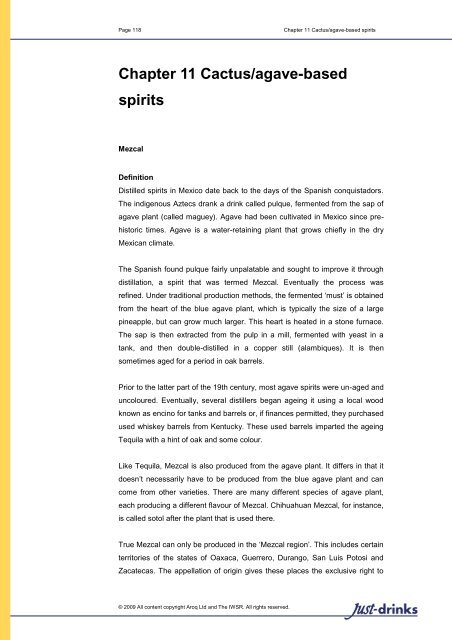Global market review of functional soft drinks ... - Just-Drinks
Global market review of functional soft drinks ... - Just-Drinks
Global market review of functional soft drinks ... - Just-Drinks
Create successful ePaper yourself
Turn your PDF publications into a flip-book with our unique Google optimized e-Paper software.
Page 118<br />
Chapter 11 Cactus/agave-based spirits<br />
Chapter 11 Cactus/agave-based<br />
spirits<br />
Mezcal<br />
Definition<br />
Distilled spirits in Mexico date back to the days <strong>of</strong> the Spanish conquistadors.<br />
The indigenous Aztecs drank a drink called pulque, fermented from the sap <strong>of</strong><br />
agave plant (called maguey). Agave had been cultivated in Mexico since prehistoric<br />
times. Agave is a water-retaining plant that grows chiefly in the dry<br />
Mexican climate.<br />
The Spanish found pulque fairly unpalatable and sought to improve it through<br />
distillation, a spirit that was termed Mezcal. Eventually the process was<br />
refined. Under traditional production methods, the fermented ‘must’ is obtained<br />
from the heart <strong>of</strong> the blue agave plant, which is typically the size <strong>of</strong> a large<br />
pineapple, but can grow much larger. This heart is heated in a stone furnace.<br />
The sap is then extracted from the pulp in a mill, fermented with yeast in a<br />
tank, and then double-distilled in a copper still (alambiques). It is then<br />
sometimes aged for a period in oak barrels.<br />
Prior to the latter part <strong>of</strong> the 19th century, most agave spirits were un-aged and<br />
uncoloured. Eventually, several distillers began ageing it using a local wood<br />
known as encino for tanks and barrels or, if finances permitted, they purchased<br />
used whiskey barrels from Kentucky. These used barrels imparted the ageing<br />
Tequila with a hint <strong>of</strong> oak and some colour.<br />
Like Tequila, Mezcal is also produced from the agave plant. It differs in that it<br />
doesn’t necessarily have to be produced from the blue agave plant and can<br />
come from other varieties. There are many different species <strong>of</strong> agave plant,<br />
each producing a different flavour <strong>of</strong> Mezcal. Chihuahuan Mezcal, for instance,<br />
is called sotol after the plant that is used there.<br />
True Mezcal can only be produced in the ‘Mezcal region’. This includes certain<br />
territories <strong>of</strong> the states <strong>of</strong> Oaxaca, Guerrero, Durango, San Luis Potosi and<br />
Zacatecas. The appellation <strong>of</strong> origin gives these places the exclusive right to<br />
© 2009 All content copyright Aroq Ltd and The IWSR. All rights reserved.






